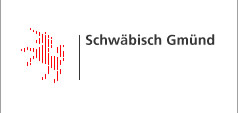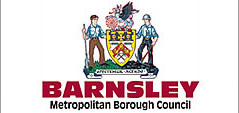News Archive
Posted 01/08/14
Ey up Gmund, once again, tha's done us real proud !
Whistle stop tour to Alsace and the ‘happenings’ in Schwäbisch Gmünd voted a great success!
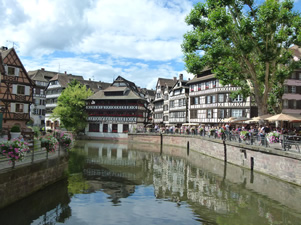 Picturesque Strasbourg was a good start and warm and sunny weather set the tempo for an inspiring and intoxicating week.
Picturesque Strasbourg was a good start and warm and sunny weather set the tempo for an inspiring and intoxicating week.
A visit to English Protestant church St Pierre de Jeune to discover a hidden gem of a cloister began our tour of the sights of the city.
Then Place Kléber, the largest square at the centre of the city of Strasbourg, it was named after general Jean-Baptiste Kléber, born in Strasbourg in 1753.
In the square is a statue of Kléber, under which is a vault containing his remains.
On the north side of the square is the imposing Aubette (Orderly Room), used by the military and later as a music school (portraits of famous composers still adorn the frontage) built by Blondel in 1765-1772.
Next to Strasbourg Cathedral or the Cathedral of Our Lady of Strasbourg (French: Cathédrale Notre-Dame-de-Strasbourg, German: Liebfrauenmünster zu Straßburg) is a Roman Catholic cathedral in Strasbourg. Although considerable parts of it are still in Romanesque architecture, it is widely considered to be among the finest examples of high, or late, Gothic architecture.
Everyone’s favourite Petite France next, with its medieval half-timbered houses and baroque sandstone buildings, where the river splits up into a number of canals and the most recognised and photographed view of Strasbourg. We were informed that the name "Petite-France" (Gerberviertel in German) was named by the former German inhabitants, not for architectural reasons but because of the numerous prostitutes working there in the Middle Ages — prostitution used to be known in Germany as "the French business". Also, syphilis often contracted in that specific area was then known as Franzosenkrankheit ("French disease"). Today it is an exquisite myriad of shops and eateries in a relaxing riverside setting, ……… aaaah!
Pont Couverts bridge over the canal with its three towers provided the perfect viewing point for a spectacular light show shown several times each evening and projected onto the walls of Barrage Vauban. Another equally impressive light show took place simultaneously on the frontage of the Cathedral in the city centre.
After some doubt and with careful negotiation our visit to the European Parliament chamber was both very informative and for many in the group, ‘an eye opener.’ Our enthusiastic Spanish born tour guide explained the workings of the European parliament including in her opinion the need for ‘mad’ Le Farage and the other groups on the floor of the chamber, dollar ‘bannannas’ and EU bananas and straight cucumbers. As a result many of our Euro-sceptic members clearly had a different perspective and the visit had changed their view of the European Parliament.
 Dominating the Plain of Alsace at 757 metres high, the Haut-Kœnigsbourg castle stands out with its imposing pink sandstone structure and it was here that we began our dip into the Alsace region.
Dominating the Plain of Alsace at 757 metres high, the Haut-Kœnigsbourg castle stands out with its imposing pink sandstone structure and it was here that we began our dip into the Alsace region.
Built in the 12th century it was for centuries witness to conflicts and rivalries between lords, kings and emperors.
Despite the extensive fortification works undertaken in 15th and 16th century , the Swedish artillery overcame the defences of Upper Koenigsbourg during the Thirty Years War. Besieged, looted and burned down in 1633, the castle was abandoned for two centuries.
Emperor William II commissioned the architect Bodo Ebhardt (an expert in feudal architecture) to restore the castle.
The works took eight years to complete, from 1900 to 1908 and the Emperor himself visited the site each year. It was out of the question for the Emperor to reside in the castle, he only wished to restore the ancient ruins. The era of knights was to be re-established in the castle and a medieval museum housed within its walls. From the outset the new castle was set to become a hot spot of tourism in Alsace.
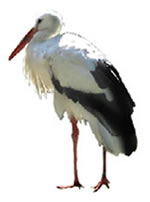
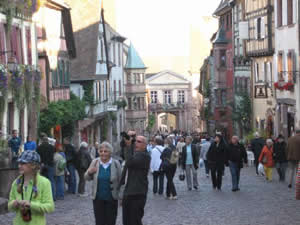 Riquewihr is without doubt one of the most beautiful villages in France. A very special combination of history, culture, scenery, and especially food and wine makes it one of the most delightful places to visit, famous for the Riesling and other great Alsace wines produced here and looks today exactly as it did in the 16th Century. Riquewihr is a wonderful and romantic little medieval city hidden between the Vosges mountains and some of the most famous vineyards in Alsace. We even managed to ‘parle’ with one of the local storks before leaving.
Riquewihr is without doubt one of the most beautiful villages in France. A very special combination of history, culture, scenery, and especially food and wine makes it one of the most delightful places to visit, famous for the Riesling and other great Alsace wines produced here and looks today exactly as it did in the 16th Century. Riquewihr is a wonderful and romantic little medieval city hidden between the Vosges mountains and some of the most famous vineyards in Alsace. We even managed to ‘parle’ with one of the local storks before leaving.
No visit to the Alsace would be complete without wine tasting, especially when you are directly on the Vin D' Alsace ( wine route ).
Edmond Rentz vineyard provided a welcomed stop and opportunity to taste several wines of this region produced in this winery. The bus journey back to our hotel was very quiet indeed I can tell you !
And so it was on to Schwäbisch Gmünd, meet and greet our friends and prepare for a welcome evening at the German Red Cross Building with which Prof. Dr. Reinhard Kunert had a great association over the past 25 years.
Our first glimpse of the Garden show came the next morning with a stroll through ‘Erdenreich’- Earth Garden.
Many were clearly disorientated to begin with as a result of so many changes to the town centre particularly around the station area and the Fünfknopfturm where so much had changed since our last visit in 2011. There was so much to see and do, the Barnsley Garden, Antibes contribution, splendid in colourful roses and the clock garden of Szekesfehervar. A play area for children with net and slide and older person’s fitness area received quite some interest, attempts to master the equipment resulted in varying degrees of success. The beach area complete with ‘Strandkorb’, Stadtpark where so much has changed and the Josefbach river area.
 Oberbürgermeister Richard Arnold formerly greeted members at the ‘Forum Gold & Silber’ building quickly renamed the “cheese-grater” by our group. Reminding everyone that 30 years ago the two societies met in Barnsley, this being the first visit of the Städtepartnerschaftverein.
Also, recalling the start of World War 1, now 100 years ago, "we have started a tradition," he said, "which we should all ensure is passed on to a younger generation."
Oberbürgermeister Richard Arnold formerly greeted members at the ‘Forum Gold & Silber’ building quickly renamed the “cheese-grater” by our group. Reminding everyone that 30 years ago the two societies met in Barnsley, this being the first visit of the Städtepartnerschaftverein.
Also, recalling the start of World War 1, now 100 years ago, "we have started a tradition," he said, "which we should all ensure is passed on to a younger generation."
There was just enough free time to visit the Blumenhalle and marvel at the many inspirational and colourful floral displays by the local florists and garden centres advertising their skills before returning back to our host and partying the night away.
Next on our whistle stop tour of the Landesgartenschau was ‘Himmelsgarten.’ Flowerbed after flowerbed filled with a co-ordinated assortment of heads each eager to feature in a mesmerising and sensational display of colour.
Where to begin? The individually designed gardens, one hectare water play area, ball pool, Forestry Commission wood promotion building (nick named by us the ‘peanut), children’s soft ball play area, the Bee colony, wedding pavilion complete with rings sculpture? We decided we needed an early morning Schnapps to help us on our way and went for the garden show distillery for sustenance.
Plum Schnapps equipped, it was time to climb the 40 metres high "Himmelsstürmer" look-out tower. Fabulous views of the sky garden together with a grandiose panorama of the Drei Kaiserberge mountains.
Himmelsgarten:
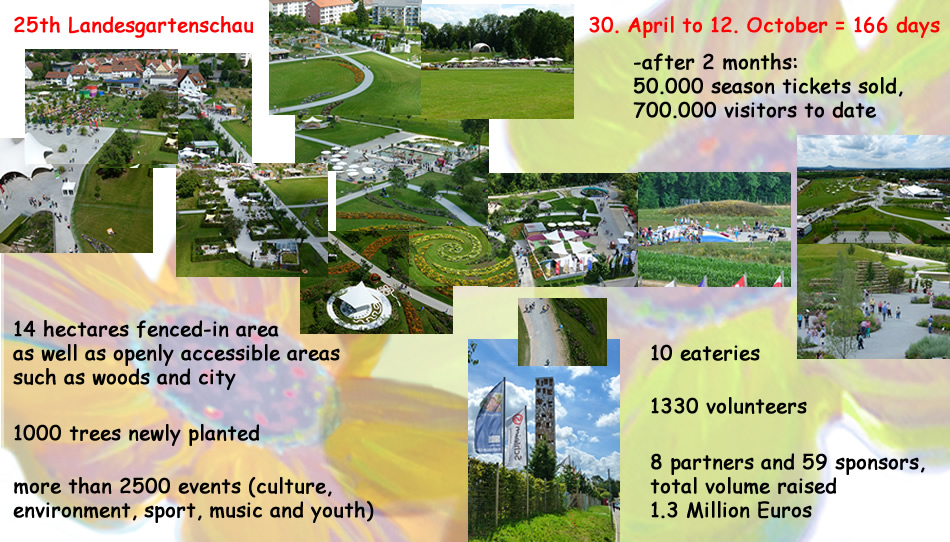
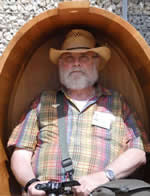 The “Ostalbtisch” was a source of a little humour, a big long table where each of the 42 boroughs of Schwäbisch Gmünd have designed and provided a chair or seat to represent their borough. In addition, each weekend throughout the entirety of the garden show they meet at the Ostalbtisch and provide a culinary speciality from their borough to the visitors.
The “Ostalbtisch” was a source of a little humour, a big long table where each of the 42 boroughs of Schwäbisch Gmünd have designed and provided a chair or seat to represent their borough. In addition, each weekend throughout the entirety of the garden show they meet at the Ostalbtisch and provide a culinary speciality from their borough to the visitors.
There were a few variations of seats represented here.
A well- earned shaded forest walk through Taubental, the link between sky garden and earth garden, revealed a few more surprises along the way.
Apart from the ‘Go Ape’ style "Waldseilgarten" there were tree witches and bonfires to discover, several life station churches, places of reflection and meditation to pause along the way.
The Kugelbahn (marble run) was a great attraction for both young and old, where upon the purchase of a wooden ball set off near the top of the wooded area, great fun could be had following it down and completing each stage of the 300M plus run to the bottom.
Back down to earth it was party time again.
Sadly, all too quickly our farewell evening was upon us and time to say ‘Auf Wiedersehen’ again. Planning has already begun for the next visit to Barnsley in July 2015 when they will couple it with a few days visit to famous author Rosamunde Pilcher country, Cornwall.
So, after construction of seven bridges and rehabilitation of two further bridges, a new tunnel, planting of 1,000 trees, 30,000 shrubs, 4,000 m² Spring flowers / summer flowers, flower meadow seeding with 6000 m² across 14 acres of land, more than 2500 cultural events, finding over thirteen hundred volunteers, ...... was it worth it? You bet it was!
Thank you to all our friends especially our hosts and to Reinhard Kunert and Siggi Starzinsky for the programme, with thumbs up we say:
Ey up Gmund, once again, tha's done us real proud !



